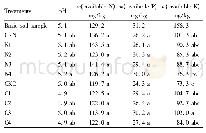《Table 1.Statistics on physical property of sandy conglomerate samples from Kongdian Formation in We
 提示:宽带有限、当前游客访问压缩模式
提示:宽带有限、当前游客访问压缩模式
本系列图表出处文件名:随高清版一同展现
《Formation conditions and accumulation characteristics of Bozhong 19-6 large condensate gas field in offshore Bohai Bay Basin》
The sandy conglomerate reservoirs in the Kongdian Formation are mainly distributed in the south of Bozhong 19-6 gas field.During the sedimentary period of the Kongdian Formation,the lake basin was in the period of initial fault depression,the area of lake basin was limited,and the range of sources was large.Sag controlled fault activity proceeded for long,with the development of fan delta deposition,providing a large number of coarse debris material close-range displacement.With the rise of the relative lake level,the fan delta had the characteristics of regressive development,forming a multi-stage superimposed,large thickness of coarse clastic sediments in the vertical upward manner(Fig.10).Drilling revealed that the maximum thickness can reach 736 m.The sandy conglomerate in the Kongdian Formation mainly originates from the Paleozoic metamorphic rock with small particle size and better sorting,and a small number of particles are the Mesozoic volcanic rock with large size and subangular-angular shape(Fig.11a,11b).That means the sources of materials are mainly Paleozoic,followed by Mesozoic.The sandy conglomerate has a porosity of 3%-14.5%,on average7.8%,permeability of(0.02-14.50)?10-3?m2,on average4.39?10-3?m2(Table 1),belonging to the ultra-low porosityultra low permeability reservoir.The reservoir space is mainly composed of pores and fractures,in which the pores mainly include primary intergranular pores(Fig.11c),intergranular dissolution pores(Fig.11d),and dissolution intragranular pores(Fig.11e).The fractures mainly include internal fractures in gravels(Fig.11f)and fractures penetrating gravels(Fig.11g).
| 图表编号 | XD0055687100 严禁用于非法目的 |
|---|---|
| 绘制时间 | 2019.02.01 |
| 作者 | XU Changgui、YU Haibo、WANG Jun、LIU Xiaojian |
| 绘制单位 | CNOOC China Limited,Tianjin Branch、CNOOC China Limited,Tianjin Branch、CNOOC China Limited,Tianjin Branch、CNOOC China Limited,Tianjin Branch |
| 更多格式 | 高清、无水印(增值服务) |





